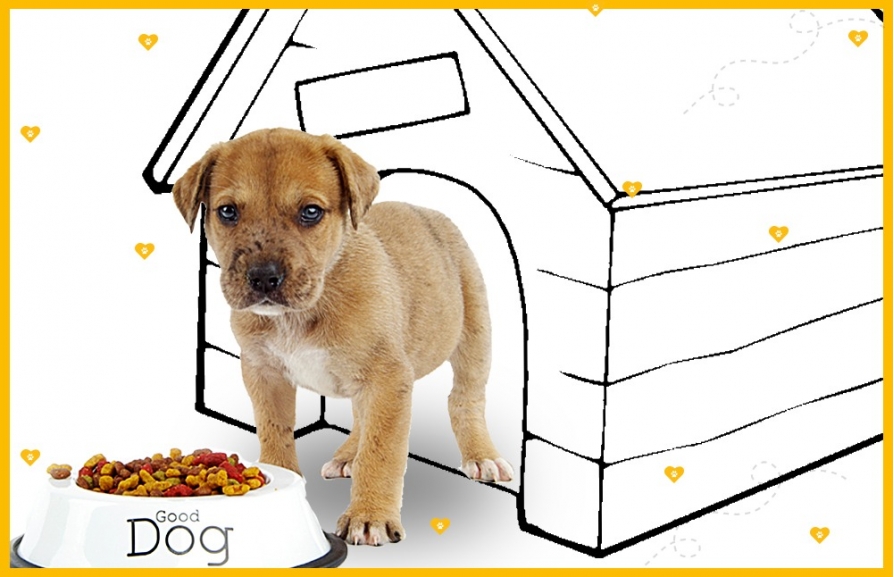Feeding a Puppy
- March 18th 2019

There is nothing more exciting than welcoming a new pup into your home. They are earnest, excitable, and just so full of joy and love, it is infectious. But being a new dog parent can be stressful – what do you feed your puppy? How much? When?!
Fret not. The Pet Project is here to lend a helping hand. Behold! – A complete guide on what to feed a puppy (including how much and when). We got you.
Puppy feeding habits versus an adult dog’s feeding habits
To begin with the most essential question: how is a puppy’s feeding habits different from an adult dog’s? The same way in which a baby or child’s feeding habits would differ from an adult’s. Puppies are growing. They are looking for a range of nutrients to help them grow faster and better: to build muscle, develop cognitive agility and just generally become the best versions of themselves. Puppy food is high in calories, protein and nutritional supplements for exactly this reason.
Feeding schedules for a new pup would also differ from an adult dog’s. New pups sleep a lot more than an adult dog, so they need to be fed more frequently, in between their naps. When they are awake though, they are a lot of energy – so be prepared!
What do you feed a puppy?
Puppies usually stay with their mother for the first eight weeks and drink their mother’s milk. It is important to keep the puppy with their mother during this time, as they develop important socialization skills by being around their brothers and sisters. If for some reason your puppy cannot be kept with their mother – the mother is ill, for instance – then check with your vet on what the best course of action is. There are puppy formula and milk bottles specially designed for feeding puppies.
At around seven to eight weeks of age, you should try and start changing your puppy over to solid food. This is not an overnight process and should be done gradually. Start by mixing some solid puppy food with milk and see how your pup takes it. You may have to keep it watery to begin with and then slowly reduce the quantity of milk in the food.
Always make sure you choose high-quality puppy food as the basis of your diet. This is not the same as dog food as it has a different combination of nutrients to help your pup grow faster.
If you want to
introduce natural foods as an occasional variation in what your puppy eats,
then try feeding them raw meat. The RSPCA recommends raw lamb, diced into small
pieces. Only introduce this once your puppy can chew solid food, of course. Too
much raw meat is also not good for them at this stage, so be careful about how
often you feed them.
What not to feed your puppy
Processed meat – Do not feed your puppy sausages or other such processed meat. This is not good for their systems and will not provide them with the nutrition they need.
No meat at all – While your dog can eat a plant-based diet (unlike cats, who are obligate carnivores), such a diet is especially bad for them when they are puppies and are growing. Always make sure that meat is the first ingredient of any puppy food that you buy. Your pup needs that protein to grow properly and not develop any nutritional deficiencies .
Cooked bones – If you feeding your puppy bones, make sure they are not cooked. Cooked bones become soft and can splinter, harming your pup’s mouth, throat and intestines. Bones, in general, can be dangerous, so just be careful if you do plan to give your puppy bones to chew. Make sure the bones are large so that your puppy cannot accidentally swallow them.
Forbidden items – There are some food items that are forbidden in a puppy’s diet, as they can seriously affect your dog’s health. This includes onions, coffee, chocolate, coconut, garlic and so on.
When and how much to feed your puppy
Most pet parents feed their puppies about three to four times a day, but this does depend on your pup. Feeding schedules are nice, as they inculcate a sense of routine and rhythm, but they may not always be possible. It is important to decide on the amount of food you need to feed your puppy in a 24-hour period and stick to it.
How much food your puppy needs will depend on their size, weight and their breed. Most dog food brands offer puppy feeding charts on the label, so that is a great place to start. Feeding charts can also be found online . These charts are for average dogs, so if your dog needs more specific advice, check with your vet.
Don’t overfeed!
Puppies need a high amount of calories to grow, yes, but overfeeding can also become a problem. Your puppy is not starving, don’t worry, even when they want more food. Some dog breeds just like food, like Labradors.
It is also important to take into account puppy treats when thinking about your puppy’s diet. Most pet parents train their puppies with treats as motivation, which can add up to quite a few calories over the weeks and months. Don’t forget to count this.
Puppies naturally have some baby fat but they should usually lose this after the first 10 weeks. Vets use a body conditioning score – which ranges from one for very thin to five for obese – to measure a puppy’s weight. By the 10th week, your puppy should be a two on this scale. We recommend keeping track of your puppy’s current weight as compared to their ideal weight. Always check with your vet if you are worried.
